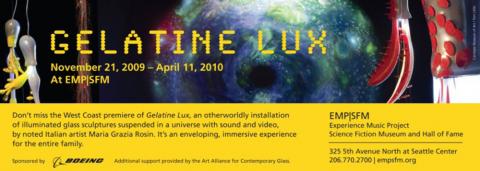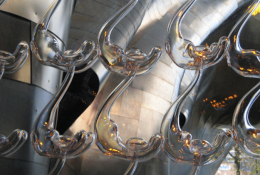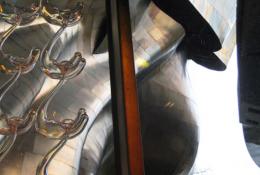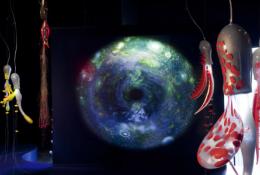Gelatine Lux
Of immediate, strong visual impact are Rosin's glass suspensions, which were crafted in Murano, Italy by master glassblowers Pino Signoretto, Silvano Signoretto, Sergio Tiozzo and Andrea Zilio. Evoking the forms of both marine and microscopic life, they exist in a mysterious intra/extraterrestrial cosmos that envelops and disorients the viewer and raises questions about the origins of the world.
Rosin's early pictorial works with their swirling, visceral vibrating movement were clearly destined to one day make the leap into 3D. When she began working in glass in 1992, Rosin effortlessly carried into her new medium all of the palpitating verve she had previously embedded on canvas. Her unending fascination with science—from marine biology to the physics of black holes—still remains a potent source of inspiration.
In addition to the illuminated glass sculptures resembling otherworldly octopuses, jellyfish and crab claws, she completes her conceptual environment with equally otherworldly sound and video elements. Rosin describes the cumulative effect of the glass, sound and video elements as "a seductive sensory machine."
Black Water Hole, her video concept which is realized with the expert technical support of Andrew Quinn, reflects Rosin's profound interest in the phenomenon of black holes. The video poetically transposes into digital imagery the effect of the swirling waters in the underworld of the Venetian lagoon that occasionally surge upwards to wreak havoc in the city.
Gianni Visnadi and David Mora, known as "Visnadi&Camomatic" successfully bring to life Rosin's concept that her glass invertebrates should communicate not just visually, but also audibly. The exhibition's complex sound component, entitled "Glass Tongues," therefore provides clues as to what these creatures might be saying to each other—and to us—in their variety of voices, inflections and moods that morph from quiet reflection to chorus and, at times, chaos.
The exhibition is one of a series of Rosin's installations titled Gelatine Lux (in Latin, "gelatinous light"). Light is an essential part of her work. This is evident in her use of the chandelier form, a quintessential Venetian glass type that goes back to the early 18th century. Using sophisticated LED and fiber-optic lighting, Rosin explodes the traditional chandelier out of its historical context with her innovative and thought-provoking designs.
Gelatine Lux was curated by Sarah Nichols, CMA's adjunct curator of decorative arts.
MARIA GRAZIA ROSIN | SHORT BIO
Maria Grazia Rosin, who lives in Venice, Italy, has been working in glass since 1992 and was a featured artist in the 2009 Venice Biennale with Gelatine Lux.
She has been featured in solo exhibitions at:
FORUM 62,Carnegie Museum of Art Pittsburgh (USA) 2009; Gelatine Lux, Palazzo Fortuny, Venice (2007); Gelatine Lux, Caterina Tognon Arte Contemporanea, Venice (2006); GANXI, La Galerie Italienne, Paris (2006); VETRORGANISMI, Galleria Civica, Cortina d'Ampezzo, Italy (2001); and STRANO MA VETRO, Museo Correr, Venice (2000).
Her work has also been presented regularly in group shows, including:
European Design since 1985: Shaping The New Century, Indianapolis Museum of Art (USA) 2009; Art Forms from the Ocean-National Glass Centre, Sunderland (UK) 2008; Viva Vetro! Glass Alive!, Carnegie Museum of Art (2007); XX Century Venetian Glass, Eretz Israel Museum, Tel Aviv (2005); Vetri nel Mondo Oggi, Venetian Institute of Science, Literature and the Arts, Venice (2004); and Venice and the Touch of Glass, Italian Institute of Culture, London (2003).



